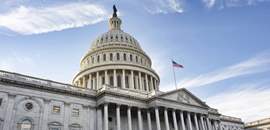The recent surge in COVID-19 cases and hospitalizations has resulted in partial shutdowns of businesses in several states that threaten to dampen the pace of U.S. economic recovery. Yet there is little sign that Congress is close to passing legislation that will provide relief to those hurt by the pandemic.
The main stumbling block between Democrats and Republicans continues to be over the size and composition of the relief package. President-elect Biden this week called on Congress to pass a bill like the $2.2 trillion HEROES Act that House Democrats passed in early October. However, Senate Majority Leader Mitch McConnell’s latest offer of $500 billion is well below his initial offer of $1 trillion and the White House’s offer of $1.9 trillion before the November elections.
All of this makes one wonder if politicians on both sides are willing to let Rome burn rather than address the critical issues facing the nation. Following is my take on what is essential to bolster the economy and what is less critical.
At the top of the list is the need to extend relief provisions for unemployed Americans. If the Pandemic Unemployment Assistance (PUA) and the Pandemic Emergency Unemployment Compensation (PEUC) lapse after Christmas, about 12 million jobless workers would be left without any assistance. The PUA program provides benefits to 7.3 million contractors, self-employed and gig workers, while the PEUC program provides an added 13 weeks of benefits to jobless workers once their state benefits lapse.
One program that expired at the end of July was a $600 weekly supplement for unemployment compensation. The unemployment benefit resulted in the median jobless worker receiving income equal to 145% of their former wages compared to 50% in prior circumstances. According to the JPMorgan Chase&Co. Institute, spending by the unemployed increased by 22% upon receipt of their benefits, and it declined by 14% in August when the program expired. The Morgan report concludes that “without further government support or significant labor market improvements, jobless workers may exhaust their accumulated savings buffer, leaving them with a choice to further cut spending or fall behind on debt or rent payments.”
By comparison, the case for extending direct payments of $1,200 per taxpayer and $500 per dependent seems less compelling as the economy is not in dire straits. Such transfer payments enabled households to maintain their lifestyles while the economy plummeted in the second quarter. They also provided a financial cushion for the recipients, as the personal saving rate spiked to 33% in the second quarter. While the rate has since eased back to 14.7% in September, it is still well above the average household saving rate of 7%-8% before the pandemic.
Another priority is the need to provide assistance to small and medium size businesses. The CARES Act recognized this with the creation of the Principal Protection Program (PPP) that converted government loans into grants if workers were retained on the payrolls. Similarly, the Heroes Act includes provisions to improve the PPP program while delivering targeted assistance to restaurants, nonprofits and event venues, as well as additional assistance for airline workers, education, and child care.
One issue that has surfaced, however, is whether PPP is meeting its stated goals. A study by the Becker, Friedman Institute of the University of Chicago reports mixed results. First, the study finds that some funds initially flowed to regions that were less adversely affected by the pandemic due to the role that banks played in identifying borrowers. Second, the effects on employment were small relative to the size of the program, as many firms that were recipients used the proceeds to make non-payroll payments and to build savings buffers.
The key challenge today is that many of the troubled firms could be on their last legs: The pandemic has lasted longer than the PPP program envisioned and widespread application of vaccines is not expected until spring. Thus, modifications to the program are needed to ensure it will have a bigger economic impact than the initial round.
Finally, the most contentious issue relates to assistance to states and municipalities. The HEROES Act enacted in May included nearly $1 trillion to shore up cash-strapped state and local governments. This proposal was roundly rejected by Republicans who believed it was an attempt by Democrats to bail out profligate “blue states”.
To revive the negotiations, the second version of the HEROES Act pared back the tally for state and local aid for coronavirus to $436 billion. Another $208 billion for states is specified for education spending and $32 billion for mass transit. Programs targeting IT and cybersecurity needs do not appear in the latest version. Still, the latest tally totaling $676 billion is more than $200 billion higher than state and local revenue losses projected by Brookings over the next three years.
Weighing these considerations, what’s a reasonable way to break the stalemate?
My conclusion is the most pressing need is to extend unemployment benefits immediately so those who lost their jobs due to coronavirus are not left destitute. By comparison, there’s less urgency to make transfer payments to those who have jobs as the economy has proved to be resilient. Regarding small and medium businesses, PPP was a worthwhile experiment given the dire circumstances when the pandemic hit, but the program needs to be targeted to those businesses that are most in need. Finally, federal support for state and local governments should be more limited in scope than what is in the current version of the HEROES Act.
A version of this article was originally posted to TheHill.com on November 21, 2020.



















